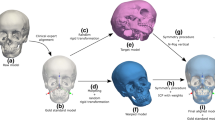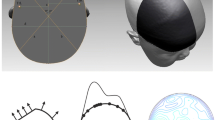Abstract
Displacement of bony component anatomy has not been comprehensively described in human cranial development. In this study, tantalum implants were used to define cranial bone position on serial cephalometric surveys. Image correction (ICCA method) was used to eliminate artifactual shift of component markers before serial analysis was used to define implant movement. In addition, applicable normative standards were used to assess all case presentations. Three normal subjects comprised a normal mixed longitudinal sample aged 2 to 84 months. Two plagiocephaly subjects were studied, one from 6 to 77 months and the other from 16 to 44 months of age. Three syndromic craniosynostosis subjects demonstrated both abnormal and normalized growth following craniotomy, from 14 to 45, from 0.5 to 5.5, and from 2 to 75 months of age. A pattern of backward rotation of cranial component anatomy was observed in three normal subjects and two plagiocephaly subjects. The posterior fossa (PF) showed the greatest growth activity, with displacement adjustments throughout the study, and the anterior cranial fossa (ACF) least growth activity, with imperceptible frontal bone movement after age 3 years. After traditional bifrontal craniotomy, an abnormal displacement growth pattern was observed from age 14 to 45 months in the patient with syndromic craniosynostosis (Pfeiffer syndrome). Extensive fronto-parietal “bossing” and grossly deficient movement in the PF were observed. However, after a bifrontal craniotomy that also crossed lambdoid sutures, a normalized pattern of displacement growth was observed in two Apert syndrome patients. These two patients with extensive syndromic craniosynostosis had cranial component pattern adjustments as in the normal and plagiocephalic subjects.
Similar content being viewed by others
References
Anonymous (1984) Answers to frequently asked questions. Department of Health and Human Services, Public Health Service, Food and Drug Administration, Rockville, Md
Baumrind S, Frantz RC (1971) The reliability of head film measurements. 1. Landmark identification. Am J Orthod 60:111–127
Broadbent BH Sr, Broadbent BH Jr, Golden WH (1975) Bolton standards of dento facial developmental growth. Mosby, St Louis
Burdi AB, Kusnetz AB, Venes JL, Gebarski SS (1986) The natural history of the cranial coronal ring articulations: implications in understanding the pathogenesis of the Crouzon craniostenotic defects. Cleft Palate J 23:28–39
Coccaro PJ, McCarthy JG, Epstein FJ, Wood-Smith D, Converse JM (1980) Early and late surgery in craniofacial dysostosis: a longitudinal cephalometric study. Am J Orthod 77:421–436
Enlow DH (1982) Handbook of facial growth. Saunders, Philadelphia
Friede H, Lilia T, Anderson H, Johanson B (1983) Growth of the anterior cranial base after craniotomy in infants with premature synostosis of the coronal suture. Scand J Plast Surg 17:99–108
Friede H, Figueroa AA, Naegle ML, Gould HJ, Kay NC, Aduss H (1986) Craniofacial growth data for cleft lip patients in infancy to six years of age: potential applications. Am J Orthod 90:388–409
Friede H, Lilja J, Lauritzen C, Anderson H, Johanson B (1986) Skull morphology after early craniotomy in patients with premature synostosis of the coronal suture. Cleft Palate J 23 [Suppl 1]:1–8
Gasser RF (1976) Early formation of the basieranium in man. In: Bosma JF (ed) Development of the basicranium. US Department of Health Education and Welfare, Bethesda, pp 29–43
Hoyte D (1975) A critical analysis of the growth in length of the cranial base in morphogenesis and malformation of face and brain. (Original article ser, vol XI/7) The National Foundation, March of Dimes, pp 255–282
Kreiborg S (1981) Crouzon syndrome, a clinical and reontgen cephalometric study. Scand J Plast Reconstr Surg [Suppl 18]:80
Kreiborg S (1986) Postnatal growth and development of the craniofacial complex in premature craniosynostosis. In: Cohen MM Jr (ed) Craniosynostosis, diagnosis, evaluation, and management. Raven Press, New York, pp 157–189
Kreiborg S, Pruzansky S (1972) Roentgencephalometric and metallic implant studies in Aperts syndrome. Presented at the 50th General Session of the International Association of Dental Research, Las Vegas, abstract 289
Marchac D, Renier D (1981) Cranio-facial surgery for craniosynostosis. Scand J Plast Reconstr Surg 15:235–243
Marchac D, Renier D (1985) Craniofacial surgery for craniosynostosis improves facial growth: a personal case review. Ann Plast Surg 14:43–54
McCarthy JG, Coccaro PO, Epstein F, Converse JM (1978) Early skeletal release in the infant with craniofacial dysostosis. The role of the sphenozygomatic suture. Plast Reconstr Surg 62:335–334
Resnick DK, Pollack IF, Albright AL (1995) Surgical management of the cloverleaf skull deformity. Pediatr Neurosurg 22:29–38
Riolo MS, Moyer RE, McNamara JA, Hunter WS (1974) An atlas of craniofacial growth: cephalometric standards from the University School Growth Study. (The University of Michigan, monograph 2 in Craniofacial growth series) Center for Human Growth and Development, University of Michigan, Ann Arbor
Rune B, Selvik G, Kreiborg S, Sarnas K-V, Kagstrom E (1979) Motion of bones and volume changes in the neurocranium after craniectomy in Crouzon's disease. A roentgen stereometric study. J Neurosurg 50:494–498
Rune B, Sarnas K-V, Selvik G, Jacobsson S (1980) Movement of the cleft maxilla in infants relative to the frontal bone. A roentgen stereophotogrammetric study with the aid of metallic implants. Cleft Palate J 17:155–174
Scott J H (1954) The growth of the human face. Proc R Soc Med 47:91–100
Sgouros S, Goldin JH, Hockley AD, Wake MJC (1996) Posterior skull surgery in craniosynostosis. Child's Nerv Syst 12:727–733
Spolyar JL, Vasileff W, MacIntosh RB (1993) Image-corrected cephalometric analysis (ICCA): design and evaluation. Cleft Palate-Craniofac J 30:528–541
Venes J, Burdi AR (1985) Proposed role of the orbitosphenoid in craniofacial dysostosis. (Concepts in pediatric neurosurgery, vol 5) Karger, Basel
Author information
Authors and Affiliations
Rights and permissions
About this article
Cite this article
Spolyar, J.L., Canady, A. Component bone marker displacements revealed by image-corrected cephalometric analysis. Child's Nerv Syst 12, 640–653 (1996). https://doi.org/10.1007/BF00366146
Issue Date:
DOI: https://doi.org/10.1007/BF00366146




